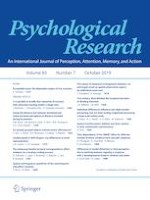21-04-2018 | Original Article
Going the distance and beyond: simulated low vision increases perception of distance traveled during locomotion
Gepubliceerd in: Psychological Research | Uitgave 7/2019
Log in om toegang te krijgenAbstract
In a series of experiments, we tested the hypothesis that severely degraded viewing conditions during locomotion distort the perception of distance traveled. Some research suggests that there is little-to-no systematic error in perceiving closer distances from a static viewpoint with severely degraded acuity and contrast sensitivity (which we will refer to as blur). However, several related areas of research—extending across domains of perception, attention, and spatial learning—suggest that degraded acuity and contrast sensitivity would affect estimates of distance traveled during locomotion. In a first experiment, we measured estimations of distance traveled in a real-world locomotion task and found that distances were overestimated with blur compared to normal vision using two measures: verbal reports and visual matching (Experiments 1 a, b, and c). In Experiment 2, participants indicated their estimate of the length of a previously traveled path by actively walking an equivalent distance in a viewing condition that either matched their initial path (e.g., blur/blur) or did not match (e.g., blur/normal). Overestimation in blur was found only when participants learned the path in blur and made estimates in normal vision (not in matched blur learning/judgment trials), further suggesting a reliance on dynamic visual information in estimates of distance traveled. In Experiment 3, we found evidence that perception of speed is similarly affected by the blur vision condition, showing an overestimation in perception of speed experienced in wheelchair locomotion during blur compared to normal vision. Taken together, our results demonstrate that severely degraded acuity and contrast sensitivity may increase people’s tendency to overestimate perception of distance traveled, perhaps because of an increased perception of speed of self-motion.
